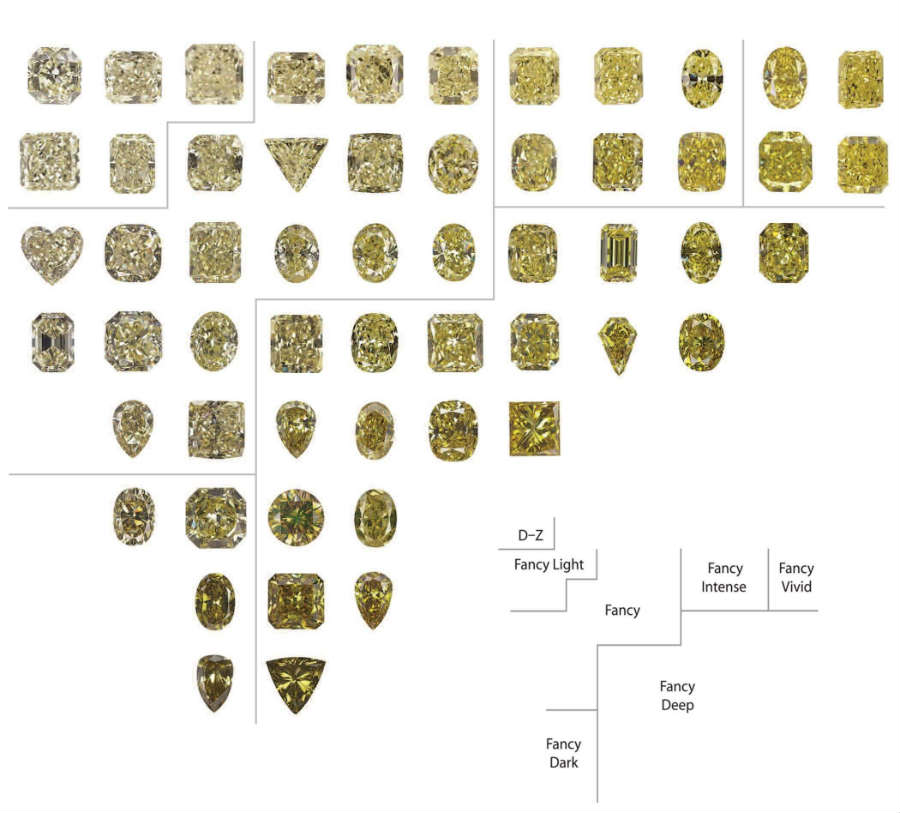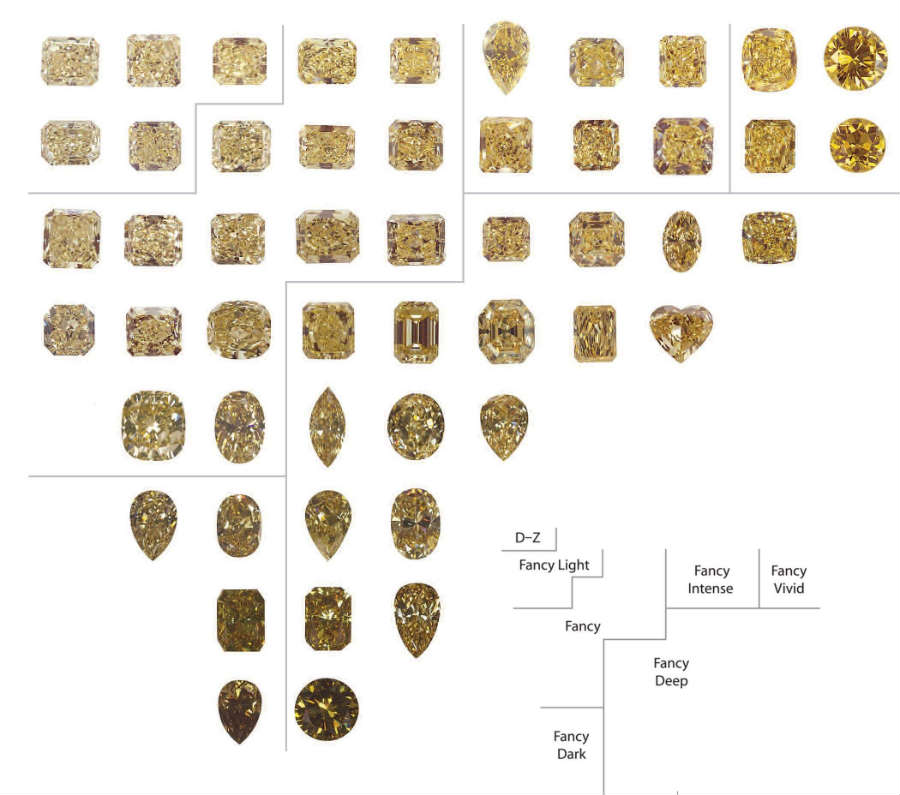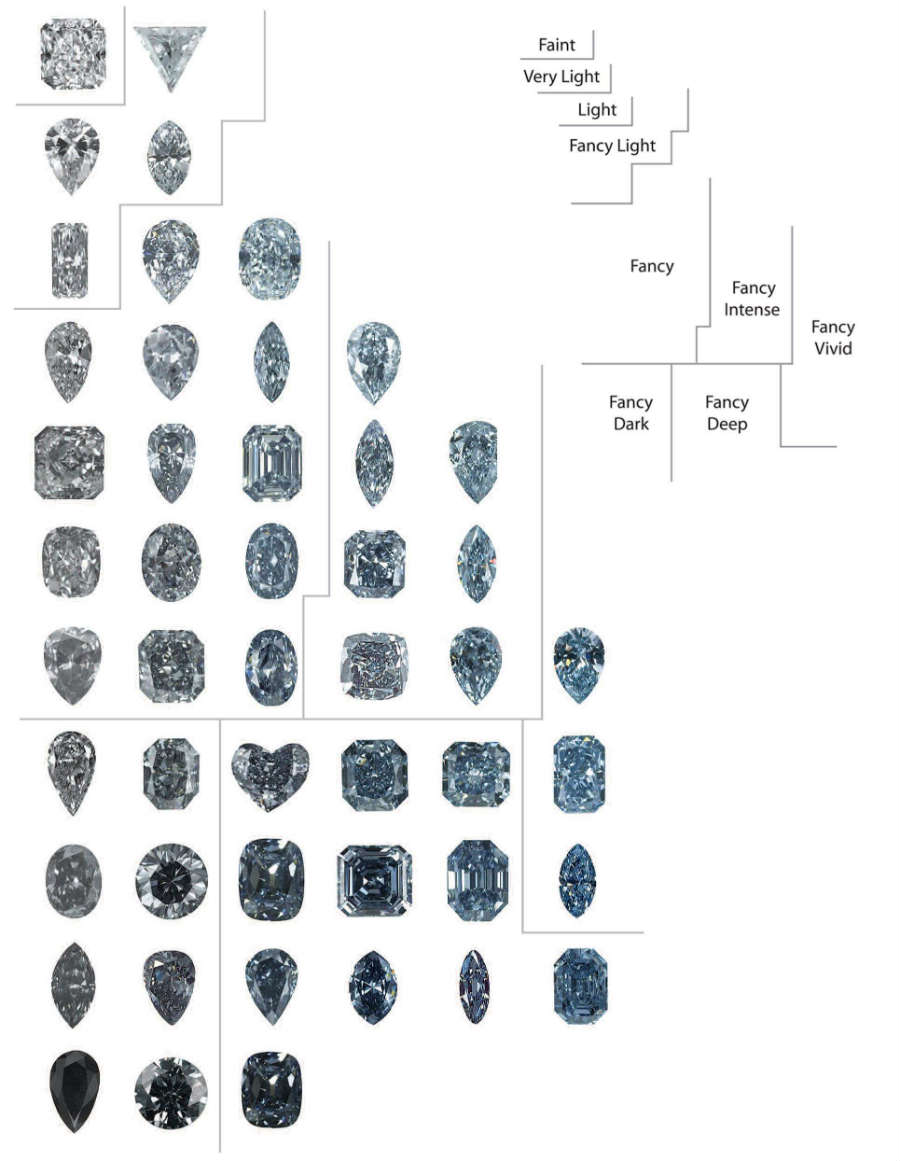Two types of diamond color charts
For most people, color is an intuitive response. But the GIA has created a systematic way to take a closer look at diamond color. The diamond color chart was designed by the GIA – the most authoritative diamond grading lab relied on by the global diamond industry.
Obviously, the diamond color chart refers to the color of the diamond, one of the 4Cs which was also designed by the GIA. But there two different types of coloring when it comes to diamonds.
One is the range between colorless and yellowish diamonds, the other is the world of colored diamonds. There are different diamond color charts for each of these categories, there is even a blue, black and yellow diamond chart. Colored diamonds are amazingly rare and have recently made huge splashes in the diamond auction world. But first, let’s start with looking at the diamond color chart for colorless diamonds.
● Diamond color chart: colorless diamonds from D to Z
The GIA Color chart ranges from D (colorless) to Z (light yellow or sometimes brown). Although a lot people expect diamonds of jewelry quality are only the colorless diamonds, this is not true. Truly colorless diamonds are actually very rare so most diamonds used in jewelry are at least nearly colorless and often have slight hues of yellow or brown. Diamonds with a very slight yellow tint are more often found in mines than truly colorless diamonds, so the prices for D, E and F color diamonds will often be at a high premium.
The GIA diamond color chart is based on how diamond grading labs determine color grades for loose diamonds. The color for each diamond color grade on the chart has been determined by so called master stones. Diamonds that are then graded by professionals are compared to these master stones, and given a color grade that corresponds with a letter on the diamond color chart. Each letter grade represents a range of color and is a measure of how noticeable a color is.
But remember, the diamonds have been graded in color-neutral environments under perfect lighting. If you put an F color diamond on a yellow golden ring band, it won’t look perfectly colorless. There is more to how the diamond looks than just the diamond color chart – check out the diamond clarity chart to see what makes a diamond sparkle.

D – H – N – Z
(GIA Diamond Color Chart)
● Diamond color chart: candy-colored diamonds
When it comes to fancy colored diamonds, the aspect of color far outweighs the other “Cs” when it comes to determining the price. Therefore, it is very important that you have an understanding of the relationship of the types of color appearances that affect color grades and descriptions.
Color is described using the three following characteristics:
- Hue: the appearance of red, blue, green, or anything in between
- Tone: the relative lightness or darkness of a color
- Saturation: the relative strength or weakness of a color
The combination of these three aspects is what makes a colored diamond unique, and what grading it receives from GIA diamond grading experts. The GIA diamond color chart standardizes the organization and classification of colored diamonds relevant to other colored diamonds. While some colors like pink and red are far rarer than other colors such as yellow, colored diamonds are truly something unique and requires the help of experts to locate. Looking at the past auctions, they certainly have increased curiosity in high net worth investment circles.
● All 27 hues on the fancy colored diamond chart
Color grades given to fancy colored diamonds consist of hue, tone, and saturation of the hue. Some of the 27 hue names include modifiers such as purplish or yellowish. A modifier like this doesn’t mean the color is weak, and it also does not affect the perceived purity of the color.

● Differences with the same color hue: Cool and Warm colors
Fancy colored diamonds are very complicated and special type of diamonds. There even exist differences in color appearances within the same color hue on the diamond color chart seen above. For example, in the yellow diamond color hue range: warmer colors trend towards the yellow/orangey-yellow hue boundary, and cooler ones towards the yellow/greenish yellow boundary. Paler yellow diamonds are part of the GIA diamond color chart for colorless diamonds with the D to Z color scale. Below you can see the yellow diamond color chart, and all the different possibilities according to their hue, tone, saturation, and modifiers.


● Blue Diamond Chart: less variation in saturation
Blue diamonds are the opposite of that dizzying range of yellow diamonds. As you can see in the blue diamond chart below, blue diamonds have a much narrower saturation range, but they do have a lot of variation in tone. Blue diamonds reach the highest saturation in the range of medium to dark tones, which you can see at the lower right of the chart. The fact that blue diamonds have less variation than yellow diamonds also reflects their rarity (coincidentally), blue diamonds are one of the rarest diamonds ever to be mined.

● Diamond color chart prices
The diamond color chart only standardizes the evaluation of the color of the diamond, it does not give you a specific diamond price. This is because the other Cs (carat, cut, clarity) also play a big role in the quality of the diamond and therefore the price. It is true that a D diamond price is usually higher than a G diamond price – but not if the G diamond is five times the size (carat weight). Therefore, we strongly advise you talk to your diamond expert and see which color diamond fits your budget and matches your taste.
Don’t worry, with the expertise of Diamond Registry consultant, you can get a sparkly diamond full of life with any type of budget. That’s because you’re buying loose diamonds at wholesale prices.
Ask for a free quote to start your journey, on the look for that perfect colored diamond.






